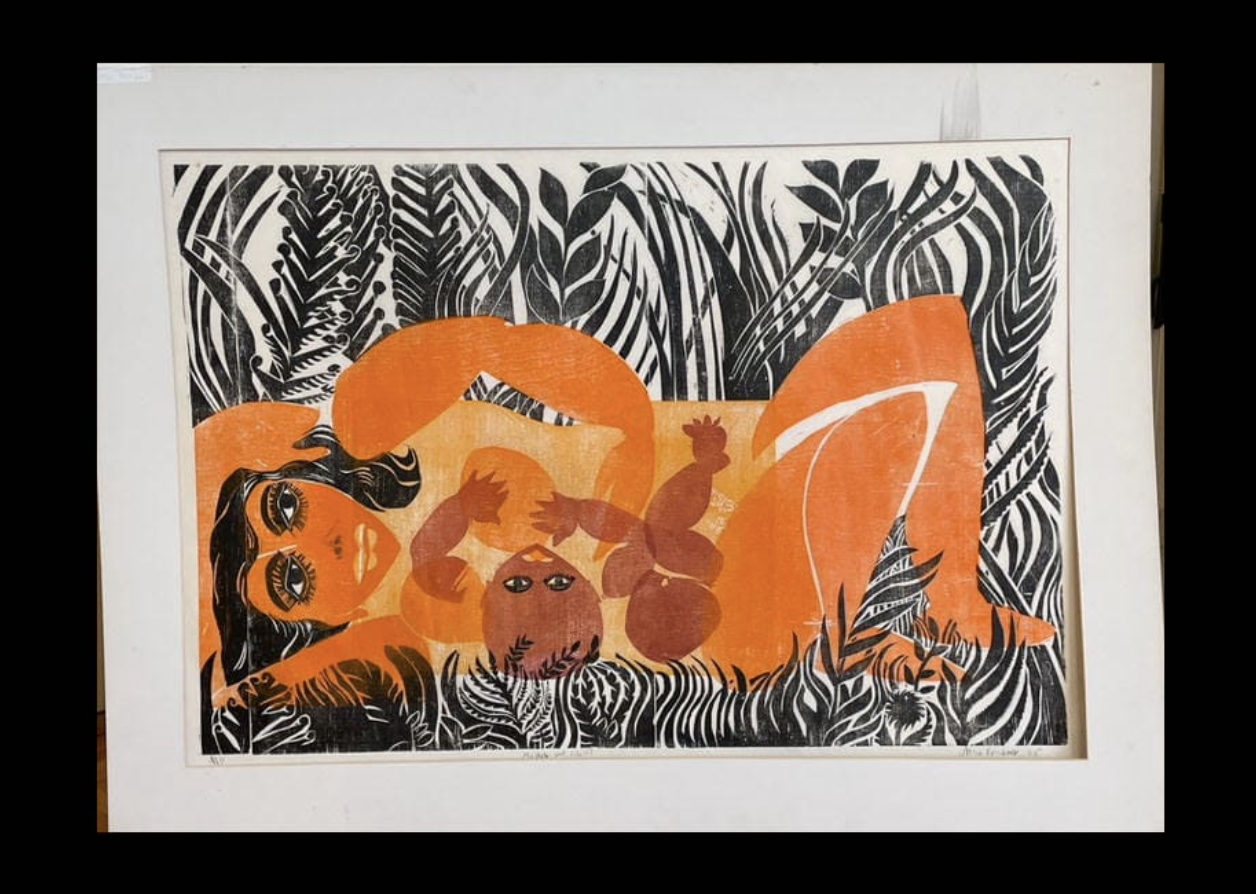 “Tlinglit Mother and Child,” by Judy Quitoriano. Currently at Las Laguna Art Gallery.
“Tlinglit Mother and Child,” by Judy Quitoriano. Currently at Las Laguna Art Gallery.
Both art and motherhood demand long hours, patience, and passion.
To honor Women’s History Month, we are taking a moment to consider all the artist-mothers who are exploring ways to nurture their art practices while raising children.
Being an artist requires time—so much uninterrupted time. And, being a mother requires the patience to field constant interruption.
How do artist-mothers harmonize these opposing demands?
What can we learn from the artist-mothers before us?
The British sculptor Barbara Hepworth (1903-1975) faced a tremendous challenge when she gave birth to triplets in 1934. Her partner, the artist Ben Nicholson, fled to Paris right after the babies were born. Left alone to care for the frail newborns as well as their four-year-old son in a small, cold London apartment, she cried nonstop and wrote letters to people expressing her desperation.
When she was presented with the opportunity to send the triplets to full-time daycare at the age of four months, she agonized over the right decision. As the art historian Caroline Maclean wrote, “The thought of not having them with her made her deeply unhappy, but the thought of not being able to do her work also made her deeply unhappy.”
Hepworth went on to become an important sculptor but was regularly criticized for “abandoning” her children to make art. Her husband, on the other hand, was praised for his artistic talent without mention of his personal life decisions.
The American painter, Alice Neel, faced a similar situation while living in 1930s New York. Her first daughter died during infancy, her second one was taken away from her by her husband’s family. Subsequently, she gave birth to two sons but raised them on her own. Neel could barely support her family but persisted as a painter until she finally started getting recognition in the 1960s.
Like Hepworth, Neel was criticized for being a “bad mother” by prioritizing her career over her children.
Women had a hard enough time making it as artists in a male-dominated scene, but when they succeeded as artists, they were criticized for failing as mothers. You can read more about Neel and other artist/writer mothers in the incredibly well-researched book, The Baby on the Fire Escape: Creativity, Motherhood, and the Mind-Baby Problem.
What are the present-day challenges to artist-mothers?
Most mothers become artists well before they enter motherhood. They’ve honed in on their craft and seen the world through artist-eyes for decades before entering parenthood. And when they try to merge the two roles, it isn’t a simple process.
Combining parenting with a creative practice changes everything–not only how an artist finds space and time to approach her work, but how the artist thinks about the work itself.
On top of that, society treats her differently.
The British contemporary artist Tracey Emin was especially harsh regarding this subject in a 2014 interview: “There are good artists who have children. Of course, there are. They are called men.”
While a lot has changed since Alice Neel juggled childcare and art in the 1930s, artist-mothers still face a gross lack of resources and wrestle with major postpartum shifts in their physical and mental core.
 “Mother and Child,” by Alice Brikner
“Mother and Child,” by Alice Brikner
Leading up to writing the 2021 book The Maternal in Creative Work, performance artist Elena Marchevska reflected on her early days as a mom in The Guardian article, “Motherhood is not a problem to solve, but a reality we must acknowledge:”
“Very quickly I realized that all the shows, openings, and parties inconveniently started at the same time: the dreaded “bath and bed” hour, when you and your child are in tatters.
I got tired of making excuses and started to ignore invitation emails and phone calls. The creative world felt like a lonely place. In spite of the richness of motherhood, I felt like a poor artist. As literary critic and writer Cyril Connolly snobbishly asserted back in the 1930s: “There is no more sombre enemy of good art than the pram in the hall.”
What is changing today for artist-mothers in terms of resources?
While mothers in creative fields continue to face challenges, they have also come together in beautiful ways to change the conversation and landscape.
In 2012, the Pennsylvania-based artist, Lenka Clayton, founded The Artist Residency in Motherhood to encourage artist mothers from all over the world to connect and support one another in their practices. ARiM offers tools, templates, stories, and mentorship to help moms continue to make art and find support.
 “Anna Belle and My Mother,” Gina Leon
“Anna Belle and My Mother,” Gina Leon
How are mothers being represented in art today?
In 2020, artist Laurel Nakadate and museum director Marisa Sage launched the exhibition “Labor: Motherhood and Art” to showcase an impressive roster of artists addressing the subject of motherhood in their work. Artworks included Yoko Ono’s interactive piece “Mommy is Beautiful” in which the audience added their own tributes to motherhood.
In 2021, Cleveland Art Museum exhibited 34 artists in the group exhibit Picturing Motherhood Now in which “the artists use motherhood as a lens through which to examine contemporary social issues—the changing definitions of family and gender, the histories and afterlives of slavery, the legacies of migration, and the preservation of matrilineal Indigenous cultures.”
The Artist Mother podcast hosts regular conversations in which artist mothers provide detailed, often humorous accounts about how motherhood changed their art practices. There is also a free online index devoted to artworks and research addressing the subject of reproductive choices in relation to artmaking (which of course includes the choice not to have children).





